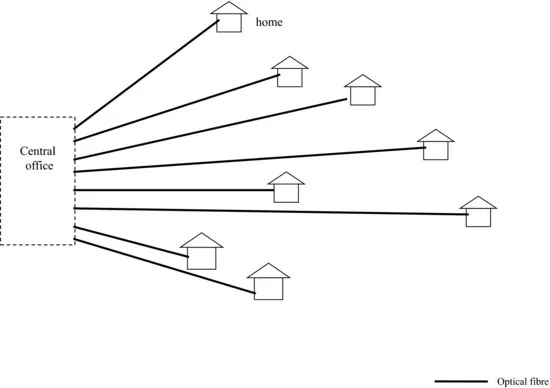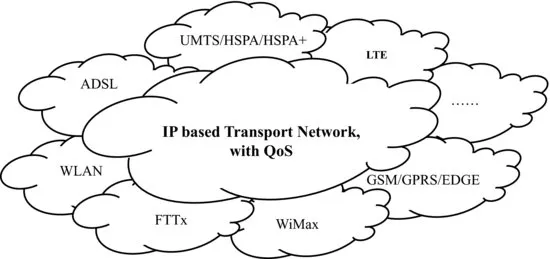![]()
1
The Multiradio Access Network
1.1 Introduction
Network evolution in the past decade regarded the introduction of new access technologies, both fixed and wireless, using an Internet protocol (IP) backbone for all originating and terminating services. The evolution of the fixed access network mainly concerns the introduction of the optical fibre, with point-to-point or passive optical network (PON) architectures.
Gigabit passive optical network (GPON) architectures deal with fibre optic deployment up to different points in the access network:
- Fibre to the cabinet (FTTCab), if the fibre stops at the cabinet,
- Fibre to the building (FTTB), if the fibre stops at the building, and
- Fibre to the home (FTTH), if the fibre stops at the customer's home.
Figure 1.1 shows FTTCab, FTTB and FTTH network architectures. Such architectures reach a downstream bit rate per user in the order of magnitude respectively up to 50 Mbps, up to 100 Mbps and up to 1 Gbps. The optical network is called passive because of the splitters, which repeat the input signal. The outgoing bandwidth of an optical line termination (OLT) is shared among many optical network units (ONUs), and in FTTCab and FTTB architectures the existing copper cable pair is used in the connection from the ONU up to the end users, with very high digital subscriber line (VDSL) transmissions. If the optical fibre reaches the home, the architecture is FTTH and the user will be provided with an optical modem called network termination (NT).
In the point-to-point architecture, there is one optical fibre connecting the end user to the central office, completely replacing the copper cable pair. In this case one fibre is dedicated to one user and therefore the provided bandwidth can be very high, even tens of Gbps. Figure 1.2 shows an example of the point-to-point fibre architecture in the access network.
The point-to-point architecture, handling much more fibre optics than GPON, requires more spaces in the central office and absorbs much more power. Because of that, most operators have chosen the GPON architecture for fixed access network evolution.
The next generation access network (NGAN) also includes radiomobile and wireless access technologies that, thanks to the adoption of advanced radio features, reach a maximum bit rate of hundreds of Mbps. Among radiomobile technologies, the global system for mobile communications (GSM) and its evolutions for data transmission, the general packet radio service (GPRS) and enhanced data rates for GSM evolution (EGDE), have been largely deployed all around the world. The third generation radiomobile system, the universal mobile telecommunication system (UMTS), with its evolutions, HSPA (high speed packet access) and HSPA+ for high bit rates data transmission, has been deployed with targeted coverage in high traffic areas, like major and minor cities. Long term evolution (LTE) is operating in many countries and is going to be deployed in others. Wireless local area networks (LANs) and WiMAX (see Section 1.3.2) are other existing technologies used mostly for data but also for voice transmission.
The different access networks, which collect all originating and terminating services, are connected to an IP-based backbone, offering a transport service with quality of service (QoS). Figure 1.3 shows the network with one core and many accesses.
1.2 Radiomobile Networks
Radiomobile networks were standardized with the aim of extending the services provided by the fixed network to mobile users, by means of a wireless terminal with the ability to move while the connection is in progress.
First generation systems, like the total access communication system (TACS), provided only the voice service, which was transmitted over the radio interface using frequency division multiple access (FDMA). The digital GSM system [1], initially standardized mainly for voice service, with its GPRS and EDGE evolutions, added new features in the access network and new nodes in the core in order to optimize data transmission.
The third generation system UMTS, standardized for multimedia, includes in its evolutions HSPA and HSPA+, which are able to reach higher bit rates and decrease latency. Finally, LTE reaches bit rates of hundreds of Mbps in downlink and lower latency times. The advanced version of LTE (LTE advanced) promises rates of Gbps.
In this section second, third and fourth generation radiomobile networks are described in terms of network architecture, access network and radio interfaces.
1.2.1 GSM/GPRS/EDGE Network Architecture
Figure 1.4 shows the GSM network architecture. The first network element is the mobile station (MS), which includes the mobile terminal (MT) and the subscriber identity module (SIM). Its principal functions are transmission and reception over the radio interface, radio channels supervision, cell selection, measurements of downlink radio parameters and execution of access, authentication and handover procedures. The MS communicates through a standardized radio interface with the base transceiver station (BTS), which is the network node that realizes one or more radio coverage cells, measures uplink radio parameters, broadcasts system information and executes procedures like paging. Each BTS is connected, through the Abis interface, to the base station controller (BSC), which controls the BTS radio resources. It assigns and releases the radio channels to the mobile users, receives uplink and downlink measurements, performs intra-BSC handover, handles power control, resolves cells congestions, etc.
Because the Abis interface is not standardized, the BTSs and the connected BSCs must be from the same vendor. The BSC with its connected BTS...




